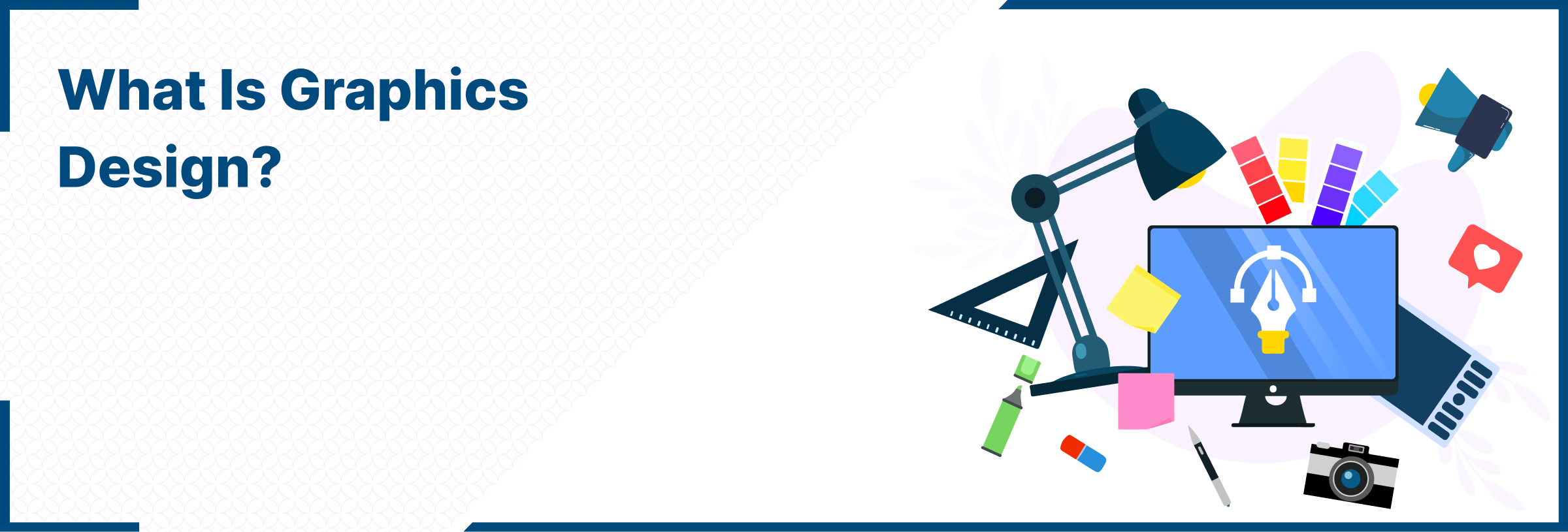What is Graphic Design?
Graphic Design is the art of creating visuals to share ideas and convey information. It is often seen in product packaging, magazines, websites, and user interfaces. It helps us to understand complex ideas clearly, make strong brand identities, sell products, and create user-friendly websites and apps. To create these images graphic designers use computer software, typography, color theory, and design principles.
Types of Graphic Design
There are various types of graphic design in which most commonly used are:
1. Brand Design
Brand Design is the practice of creating the visual elements of a brand and setting up instructions to use across all of the company’s services and products to maintain a consistent brand identity. It helps to convey the core identity and message of the company across the web.
2. Illustration
Illustrations are mostly used in web and brand design but can also be used at other places. Illustrations contains visual assests that helps the ideas to be conveyed visually in a non-text format. Designers make compositions for the purpose of communicating and solving problems, graphical artists and Illustrators make their own works.
3. Web Design
A lot of Graphic Designers works ot create the visual elements of a website. But web design and graphic design are different. Web design also requires the knowledge of UI design and UX design
4. Marketing Design
Marketing Design is making Graphics for Marketing products and services. Making promotional banners for products, making banners for sale, making print materials, etc.
5. Packaging Graphic Design
Packaging is an important marketing tool. It requires conceptual and problem-solving skills and the knowledge of print processes, as well as industrial design and manufacturing.
6. Motion Graphic
In simple words, a graphic in motion known as Motion Graphic design. This includes animations, video games, trailers etc.
7. Infographic Design
Infographics are the graphics whose sole purpose is to convey information that can be consumed visually. Infographics helps the users to grasp information faster and easily in a visual manner that can sometimes be harder to understand otherwise.
Key Elements of Graphic Design
A professional graphic designer uses a certain visual elements in creating his work. These features may be used by graphic designers, in combination with or apart from one another, for the purposes of creating compelling visual effects. These visual elements are:
a) Color
There are lots of colors we know but choosing the right color is the key to create an attractive Graphi Design. You can choose the cool or warm color template depending on the requirements. Better you give it a try of Color Theory.
b) Line
Lines can be utilized for more than just outline and content division. They can be continuous or interrupted, straight or curved, smooth or zigzagged, and more.
c) Shape
You will required lines to create any shapes, shapes can be geometric or organic. When you will try to create your own shape or designing a logo you have to be sure the elements are properly aligned or as you want them to align.
d) Form
When the sahpes become 3D that becomes form, Geometric or organinc both the sahpes play crucial role in design but the oraganic(usualy found in nature) forms feels more natural.
e) Space
There are positive space and negative space you have to carefull for both, too much of any space can make your design ugle. Positive spaces are the focus of the design and negative space is the background.
f) Texture
Texture brings the royal look into your desining and it is the surface quality of the design. Desining is all about how good and usefull your design.
g) Size
At the end size matters for all the elements, keeping everything in size make your design more genuen and eye caching.
Working Process of Graphic Design
1. Make a Creative Draft
It is a document that helps the designers to understand the project and its requirements. The document should contain every requirement and information so that no issues arise in future.
2. Conduct Research
A thorough research should be conducted depending on the scope of the project and get as much information as possible.
3. Brainstorm Ideas
Before making the final product the designer should brainstorm all possible ideas. This helps in the final design process by filtering out the best ideas possible and even mix and some of the best ones and create a wireframe.
4. Create the Design
After getting the final wireframe for the project the design should be made with careful considerations and by following design principles.
5. Take Feedback and Refine
After creating the design take feedback from the clients or the customers and work on any changes or refinements are required.
What are the common workplaces for graphic designers?
Graphic designers can be found working in many different workplaces. These are:
- Advertising agencies
- Design studios
- Marketing firms
- In-house design departments
- Publishing houses
- Printing companies
- Web development firms
- Freelance/self-employment
- Corporate offices
- Media companies
- Benefits of Graphic Design
Benefits of Graphic Design
Here are some of the benefits of Graphic Design:
- Professionalism and Consistency: Using logos, images and design may be a way to create an accurate image of your company to attract audience.
- Identity and Brand Recognition: It helps in defining your visual identity, which reflects your company’s goals and values.
- Visual communication: Beyond defining identity and brand recognition. Graphic design can be very helpful to grab attention and encouraging your audience’s curiosity.
- Increase Sales & Market Position: With the help of a good graphic design, you can convert your audience into buyers, that will lead to increased sales.





